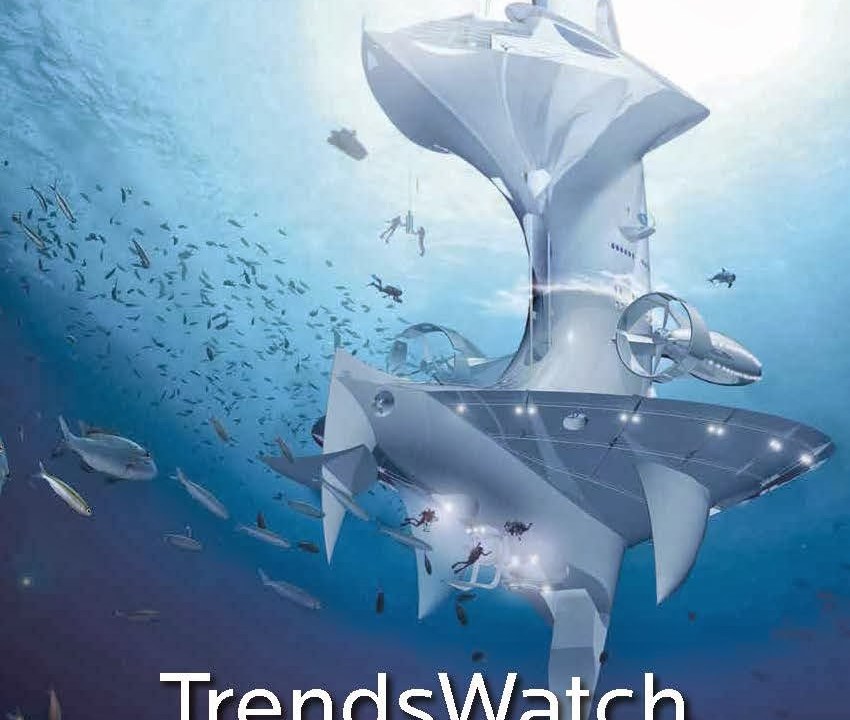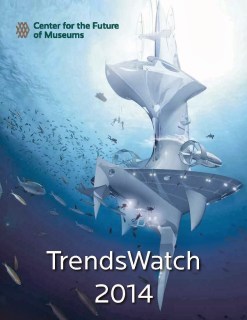
Third time is charming, right? Hope so, as I’m very pleased to share with you CFM’s third annual forecasting report—TrendsWatch 2014. After posting printed headlines from a year’s worth of stories from Dispatches from the Future of Museums on my wall and shuffling them around, the following six trends emerged from the noise:
For Profit for Good. One of our 2012 trends—NPO No’ Mo’—explored the erosion of nonprofit advantages due to the rising popularity of PILOTs (Payments in Lieu of Taxes) and other municipal fees. This year, we explore how social entrepreneurs are pioneering ways of achieving social good while forgoing nonprofit status altogether. How will the success of these mission-driven for-profits shape social and political attitudes towards the nonprofit sector?
Synesthesia. This is really the collision of two trends—the proliferation of technologies that give us new ways to capture and share scent, sound, sight, touch and taste; and the integration of multisensory stimulation into traditional experiences that used to be premised on one main sensory input. There are great examples from across the cultural sector—film, opera, theater and, of course museums—of how organizations are taking advantage of both the new sensory technologies and the popular enthusiasm for synesthetic experiences.
A Geyser of Information. Were you watching when IBM’s “Watson” beat champions Ken Jennings and Brad Rutter at Jeopardy? That’s the kind of awesome that can happen when advanced analytical computing is combined with “big data”—data sets too large to be crunched with traditional statistical techniques. The tremendous amount of data we, as a species, are generating, combined with emerging tools for making sense of this geyser of information, is creating whole new ways to see the world and predict the future. On a very practical level, it is giving businesses (including museums), powerful ways to assess their operations and impact.
Privacy in a Watchful World. Of course, the flip side of big data is the intrusive and sometimes downright creepy methods being used to collect all that information. As individuals, organizations and as a society we are just beginning to work through appropriate limits on how data is shared and with whom, and who benefits from the resulting value.
What’s Mine is Yours. Have you booked a ride through Uber, Lyft or Sidecar? Scheduled a stay using Airbnb? Arranged for canine care through DogVacay? If so, you are a participant in the “sharing economy”—downplaying ownership in favor of collaborative consumption of resources. The internet is enabling trusted intermediaries to match formerly unused bits of time and resources with frugal consumers. While this undermines many traditional industries, it opens up opportunities for museums to play matchmaker and to practice their own economies of consumption.
Robots! Ok, I admit, I am a robot junky. But, in my defense, the past year has seen an unprecedented rise of robotic innovation and application not only in society as a whole, but in museums specifically. Now we have robots performing conservation assessments, surveying field sites, even trying out for the role of interpreter. And the stories keep coming over the transom—after TrendsWatch went to press, I found out the National Museum of Australia is offering tours of via two telepresence robots, endearingly named Chesster and Kasparov.
As in previous years, the report:
- explores how each trend is playing out in the world
- investigates what this means for society and for museums
- shares examples of how museums are engaging with this trend
- suggests how museums might respond
A free PDF is available for download from the CFM website. (Apropos of two of our trends—big data and privacy—that version comes with a tracking chip that records when the report is downloaded or printed, helping us build the case to funders regarding its reach). Soon there will be print copies available through the Alliance Bookstore. We’re hoping the quantity discount for the print version will encourage use of the report as a starting point for discussions with board and staff of museums. Later this year we will release an enhanced digital version that look fabulous on digital devices, and includes videos illustrating the trends.
I’ll be exploring these themes throughout the year here on the Blog—let me know if you are engaged in related work and would like to write a guest post, or to finger a colleague as a potential author. There will also be a Board compiling images and links related to each theme over on the CFM Pinterest page.
And one specific call for assistance: I’m trying to engineer a robot demo at the annual meeting (along the lines of the 3D printing demo we did in Baltimore last year)—if you know of any museum staff, companies or individual robotics enthusiasts who might be willing to help, please drop me a line!
Yours from the future,
Elizabeth









